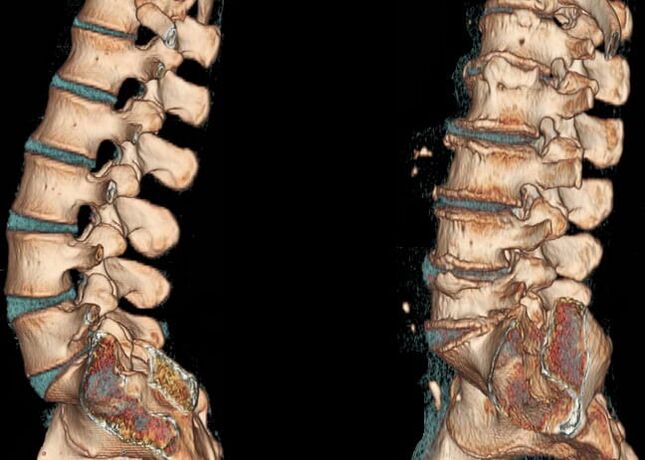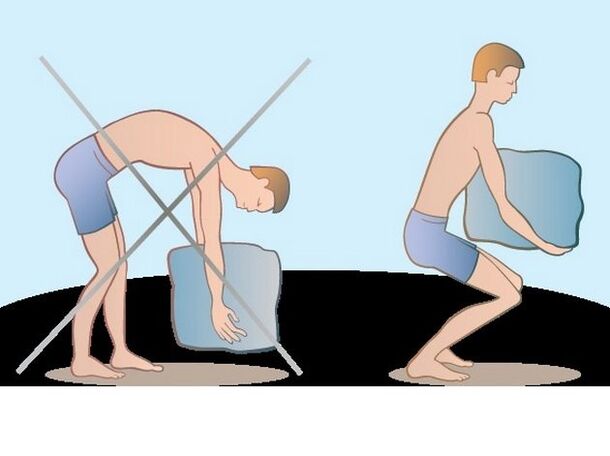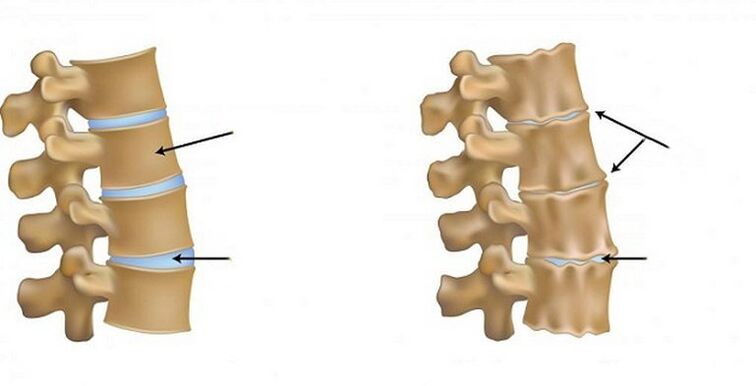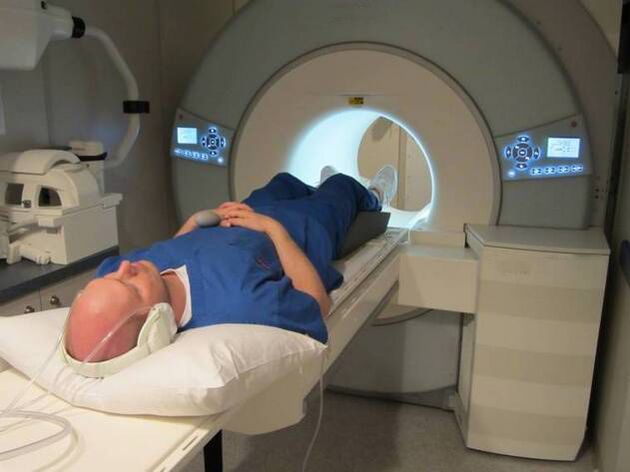
People with osteochondrosis of the lumbar spine always avoid sudden movements, lean carefully and turn to the sides, sit down slowly, rise.So they try to prevent sharp, penetrating pain in the lower back and force them to freeze in a body position.Osteochondrosis also manifests itself through crunch, clicks, restriction of mobility.Its treatment is more conservative, but surgical intervention is required with severe damage to the windows and vertebrae.
What is osteochondrosis of the lumbar spine
The osteochondrosis lumbar is a degenerative-dystrophic pathology that initially influences the intervertebral discs.Due to the insufficient nutrient absorption, you lose the ability to keep moisture.Regeneration processes slow down, slices become flat, fragile.The distance between neighboring vertebrae is reduced, so bone tissue stabilize the lumbar segment affected by osteochondrosis.Osteophytes are formed - bone growth, the shift of soft tissue structures, nerve roots and blood vessels being violated.
Pathology phases
The stage of osteochondrosis is the stage of development of the disease, which is characterized by certain destructive changes in the discs and bodies of the vertebrae.It is determined using an X -Ray test.Specific signs for the destruction of vertebral structures are clearly visible on the resulting images.Each stage corresponds to the severity of osteochondrosis, a number of symptoms.The higher it is, the more difficult the disease for conservative treatment.
| Stadium of lumbar osteochondrosis | X -Ray characteristics and clinical manifestations |
| First (preclinical) | There are no signs of osteochondrosis in X -rays.Occasionally there is unpleasant sensations in the lower back after physical exertion or long -term stay on the legs |
| The second | There is a remedy of the lordosis, less often - the scenes of the vertebral bodies, the deformation of half -monken processes.The height of the panes is slightly reduced.Painful sensations occur more often, their duration increases |
| The third | Subchondral sclerosis of the final plates, damage to a large number of crescent processes and a moderate decrease in the height of the hard drive are observed.In addition to pain in the lumbar region, the clinic contains crispness, stiffness of movements |
| Fourth | Semi -Moon processes are rejected to the outside and posterior.There is a compensatory growth of bone tissues, the formation of several osteophytes.Pain occurs when moving and in peace |
Causes of the disease

The causes of the development of osteochondrosis are often increased loads on the lumbar spine.The discs are constantly microtrauma that have no time to recover in time.An essential part is gradually damaged and starts the deformation of bone bodies of the vertebrae.Such pathological conditions are also able to provoke the destruction of the lumbar segment:
- Congenital or acquired anomalies - flat feet, scoliosis, kyphosis, valgus deformation of the foot, TBS dysplasia;
- Systemic pathologies - rheumatoid arthritis, scleroderma, red lupus;
- Endocrine and metabolic diseases, diabetes mellitus, hypo and hyperthyroidism, obesity;
- Earlier injuries - subluxation of the vertebrae and their fractures, damage to the spinal cord;
- Circular disorders, including against the background of a seated lifestyle.
One of the main causes of osteochondrosis is the natural aging of the body.After 50 years, the restoration processes slow down, collagen production decreases, the condition of the ligaments worsens.
Characteristic signs and symptoms of the disease
Osteochondrosis does not appear clinically in the early stages of development.After a working day, a person takes a weak pain of the lower back to the overvoltage of the muscles and does not consult a doctor.However, the severity of the symptoms slowly increases - soon a crunch is associated with tendencies and twists of the case, sensitivity disorders and stiffness with pain.
Rook syndrome
This is the name of the defeat of the spine roots, which leads to motor, vegetative and serious disorders.Rotor syndrome develops with osteochondrosis with 3-4 severity.In these phases, an intermediate umbrella is formed that compresses the spine roots.The pathology takes place according to the type of Lumbago, Lumbalgia and Lumbal -ilgia.In addition to severe pain, the radicular syndrome is due to sensations of numbness, tingling, crawling goose bumps, reduced or completely failed.
Ischemic syndrome

In the late stages of the course of the lumbar osteochondrosis, it is possible to compress herniacating large blood vessels.The pelvic organs no longer receive enough nutrients, which leads to a violation of their functioning.The brain brain trophy is also upset, a neurological defect occurs - intermittent lameness appears, temperature, sensitivity to pain falls.
Vertack syndrome
By reducing the distance between the adjacent bodies of the vertebrae, the growth of bone tissues, the lumbar vertebrae segments are gradually deformed.The situation is tightened by constant compensatory stress of the back muscles with its subsequent atrophy.Pathologically changes the aisle and attitude of a person, including the improper redistribution of loads.The likelihood of involving other parts of the spine and the joints of the legs in the destructive depressive is significantly increased.
Pain syndrome
There is a large sciatic nerve in the bottom of the back, which is formed by sacred spine roots.If it is injured with a hernial lead, bone growth, convulsive muscles, Ishias occurs - a typical symptom of lumbar osteochondrosis.An acute pain is spread along the sciatic nerve to the hips, knees, lower legs (lumbar spine).Another specific feature of the pathology - lumbago or "shots" in the lower back after a sharp inclination or rotating hypothermia.
Diagnostic methods

In a diagnosis, radiological images are most informative in two projections.In order to examine the affected lumbar segment in more detail, an MRI is carried out.With the study you can evaluate the condition of the spinal cord, soft tissue structures, blood vessels and nerve roots.It is possible to determine the degree of damage to the nerve trunks using the potential caused, electronography and electromyography.Discography is used to investigate the affected discs.
How the treatment is carried out
A comprehensive approach to therapy for lumbar osteochondrosis is practiced.The treatment aims to eliminate pain, restore the movement volume and prevent the spread of pathology to healthy discs and vertebrae.
Drugs
The use of non -steroidal anti -inflammatory drugs, glucocorticosteroids and muscle relaxants enables you to remove pain in the lower back.Medicines are used in therapy to improve blood circulation.Patients must be prescribed for group B vitamins, chondroprotectors.
Medical physical education
This is the most effective and affordable treatment for osteochondrosis.After 1-2 months of daily treatment of physiotherapy exercises, the muscles of the lower back, but also of the entire back, improve the attitude and accelerate blood supply for damaged connective tissue structures.LFK doctors recommend that patients recommend slow, smooth curves and fuselage tilts, flat squats and lungs.
massage
Patients with lumbar osteochondrosis show all types of massages - vacuum, acupuncture, bandage, segment.But the most popular is classic.During the session, the massage therapist carries out the main massage movements: stroking, grating, kneading, vibrations.The aim of the procedures is to eliminate muscle cramps, to improve blood circulation in the affected segment and to strengthen the skeletal muscles.
Physiotherapy
In an acute and subacute period, patients are prescribed by electrophoresis or ultrafonophoresis with glucocorticosteroids, anesthetics and vitamins of group B.Laser therapy, magnetotherapy, stressed corrugated therapy and UHF therapy are often carried out in the remission stage.Ozokeritoling, paraffin applications, hirudotherapy, mud, radon, hydrogen sulfide baths are also used.
Surgical intervention
The main display for surgical intervention is the violation of the spinal cord with a hernial advantage.During the operation, the intermediate removal is removed, the decompression of the spine canal is carried out.The most frequently used methods for surgical intervention for lumbar osteochondrosis are the microdisca domic, puncture stamping or the laser reconstruction of the hard disk, the implant installation and the stabilization of the spine.
Traditional medicine
After the main therapy, the success of a stable remission in treatment, domestic ointment, herbal teas, compresses, oil and alcohol cancellation are used.Folk remedies do not affect the cause of osteochondrosis, so they are used to eliminate weak, painful pain, severity in the lower back after hypothermia, sharp weather change or an increased physical activity.
The consequences of the lack of treatment
The development of almost all complications of lumbar osteochondrosis is provoked by the formed band fire theater.Disogenic myelopathy is particularly dangerous, which does not always turn out to be a surgical treatment.It manifests itself through pelvic disorders, including defecation disorders.The complications of osteochondrosis also include Rooser syndrome - a common cause of acute, penetrating pain in the lower back.
Prevention and forecast measures
The forecast is favorable when diagnosing a pathology of 1-2 severity degrees.It is well suited for conservative treatment, and in young patients it is even possible to partially restore the tissue of intervertebral discs.With the development of complications, the forecast for complete restoration is less cheap.
The prevention of the osteochondrosis of the lumbar spine is to control the body weight and excess loads, timely treatment of endocrine metabolic diseases.Neurologists and vertebrologists recommend visiting the swimming pool, participating with Aquaerobic, Pilates, Scandinavian walking.





















